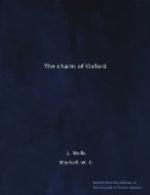“Of the colleges of
Oxford, Exeter is the most
proper for western,
Queen’s for northern, and
Brasenose for north-western
men.”
FULLER,
Worthies.
[Plate XV. Bresenose College, Quadrangle and Radcliffe Library]
Brasenose college is in the very centre of the University, fronting as it does on Radcliffe Square, where Gibbs’ beautiful dome supplies the Bodleian with a splendid reading-room. And this site has always been consecrated to students; where the front of Brasenose now stands ran School Street, leading from the old Scholae Publicae, in which the disputations of the Mediaeval University were held, to St. Mary’s Church.
It was from this neighbourhood that some Oxford scholars migrated to Stamford in 1334, in order to escape one of the many Town and Gown rows, which rendered Mediaeval Oxford anything but a place of quiet academic study. They seem to have carried with them the emblem of their hall, a fine sanctuary knocker of brass, representing a lion’s head, with a ring through its nose; this knocker was installed at a house in Stamford, which still retains the name it gave, “Brasenose Hall.” The knocker itself was there till 1890, when the College recovered the relic (it now hangs in the hall). The students were compelled by threats of excommunication to return to their old university, and down to the beginning of the nineteenth century, Oxford men, when admitted to the degree of M.A., were compelled to swear “not to lecture at Stamford.”
The old “King’s Hall,” which bore the name of “Brasenose,” was transformed into a college in 1511 by the munificence of our first lay founder, Sir Richard Sutton; he shared his benevolence, however, with Bishop Smith, of Lincoln. The College celebrated, in 1911, its quatercentenary in an appropriate way, by publishing its register in full, with a group of most interesting monographs on various aspects of the College history.
The buildings are a good example of the typical Oxford college; the Front Quad, shown in our picture, belongs to the time of the Founders, but the picturesque third story of dormer windows, which give it a special charm, dates from the reign of James I, when all colleges were rapidly increasing their numbers and their accommodation. Of the rest of the buildings of Brasenose, the chapel deserves special notice, for it was the last effort of the Gothic style in Oxford, and it was actually finished in the days of Cromwell, not a period likely to be favourable to the erection of new college chapels.
Brasenose (or B.N.C., as it is universally called) has produced a prime minister of England in Henry Addington, whom the college record kindly describes as “not the most distinguished” statesman who has held that position: but a much better known worthy is John Foxe, the Martyrologist, whose chained works used to add a grim charm of horror to so many parish churches in England; the experiences of the young Macaulay, at Cheddar, are an example which could be paralleled by those of countless young readers of Foxe, who, however, did not become great historians and are forgotten. Somewhat junior to Foxe, at B.N.C., was Robert Burton, the author of the Anatomy of Melancholy, who found both his lifework as a parish vicar, and his burial-place in Oxford.




